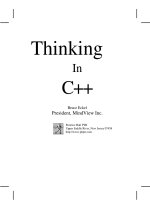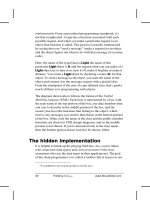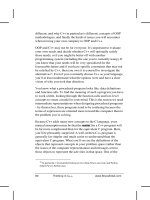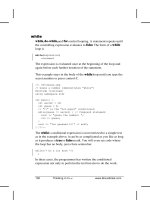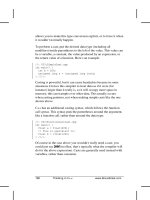Thinking in C plus plu (P9) ppt
Bạn đang xem bản rút gọn của tài liệu. Xem và tải ngay bản đầy đủ của tài liệu tại đây (163.55 KB, 50 trang )
380 Thinking in C++ www.BruceEckel.com
int main() {
cout << "sizeof(Bunch) = " << sizeof(Bunch)
<< ", sizeof(i[1000]) = "
<< sizeof(int[1000]) << endl;
} ///:~
The use of
enum
here is guaranteed to occupy no storage in the
object, and the enumerators are all evaluated at compile time. You
can also explicitly establish the values of the enumerators:
enum { one = 1, two = 2, three };
With integral
enum
types, the compiler will continue counting
from the last value, so the enumerator
three
will get the value 3.
In the
StringStack.cpp
example above, the line:
static const int size = 100;
would be instead:
enum { size = 100 };
Although you’ll often see the
enum
technique in legacy code, the
static const
feature was added to the language to solve just this
problem. However, there is no overwhelming reason that you
must
choose
static const
over the
enum
hack, and in this book the
enum
hack is used because it is supported by more compilers at the time
this book was written.
const objects & member functions
Class member functions can be made
const
. What does this mean?
To understand, you must first grasp the concept of
const
objects.
A
const
object is defined the same for a user-defined type as a built-
in type. For example:
const int i = 1;
const blob b(2);
8: Constants 381
Here,
b
is a
const
object of type
blob
. Its constructor is called with
an argument of two. For the compiler to enforce
const
ness, it must
ensure that no data members of the object are changed during the
object’s lifetime. It can easily ensure that no public data is modified,
but how is it to know which member functions will change the data
and which ones are “safe” for a
const
object?
If you declare a member function
const
, you tell the compiler the
function can be called for a
const
object. A member function that is
not specifically declared
const
is treated as one that will modify
data members in an object, and the compiler will not allow you to
call it for a
const
object.
It doesn’t stop there, however. Just
claiming
a member function is
const
doesn’t guarantee it will act that way, so the compiler forces
you to reiterate the
const
specification when defining the function.
(The
const
becomes part of the function signature, so both the
compiler and linker check for
const
ness.) Then it enforces
const
ness
during the function definition by issuing an error message if you
try to change any members of the object
or
call a non-
const
member
function. Thus, any member function you declare
const
is
guaranteed to behave that way in the definition.
To understand the syntax for declaring
const
member functions,
first notice that preceding the function declaration with
const
means the return value is
const
, so that doesn’t produce the desired
results. Instead, you must place the
const
specifier
after
the
argument list. For example,
//: C08:ConstMember.cpp
class X {
int i;
public:
X(int ii);
int f() const;
};
X::X(int ii) : i(ii) {}
int X::f() const { return i; }
382 Thinking in C++ www.BruceEckel.com
int main() {
X x1(10);
const X x2(20);
x1.f();
x2.f();
} ///:~
Note that the
const
keyword must be repeated in the definition or
the compiler sees it as a different function. Since
f( )
is a
const
member function, if it attempts to change
i
in any way
or
to call
another member function that is not
const
, the compiler flags it as
an error.
You can see that a
const
member function is safe to call with both
const
and non-
const
objects. Thus, you could think of it as the most
general form of a member function (and because of this, it is
unfortunate that member functions do not automatically default to
const
). Any function that doesn’t modify member data should be
declared as
const
, so it can be used with
const
objects.
Here’s an example that contrasts a
const
and non-
const
member
function:
//: C08:Quoter.cpp
// Random quote selection
#include <iostream>
#include <cstdlib> // Random number generator
#include <ctime> // To seed random generator
using namespace std;
class Quoter {
int lastquote;
public:
Quoter();
int lastQuote() const;
const char* quote();
};
Quoter::Quoter(){
lastquote = -1;
srand(time(0)); // Seed random number generator
8: Constants 383
}
int Quoter::lastQuote() const {
return lastquote;
}
const char* Quoter::quote() {
static const char* quotes[] = {
"Are we having fun yet?",
"Doctors always know best",
"Is it Atomic?",
"Fear is obscene",
"There is no scientific evidence "
"to support the idea "
"that life is serious",
"Things that make us happy, make us wise",
};
const int qsize = sizeof quotes/sizeof *quotes;
int qnum = rand() % qsize;
while(lastquote >= 0 && qnum == lastquote)
qnum = rand() % qsize;
return quotes[lastquote = qnum];
}
int main() {
Quoter q;
const Quoter cq;
cq.lastQuote(); // OK
//! cq.quote(); // Not OK; non const function
for(int i = 0; i < 20; i++)
cout << q.quote() << endl;
} ///:~
Neither constructors nor destructors can be
const
member
functions because they virtually always perform some modification
on the object during initialization and cleanup. The
quote( )
member function also cannot be
const
because it modifies the data
member
lastquote
(see the
return
statement). However,
lastQuote( )
makes no modifications, and so it can be
const
and can
be safely called for the
const
object
cq
.
384 Thinking in C++ www.BruceEckel.com
mutable: bitwise vs. logical const
What if you want to create a
const
member function, but you’d still
like to change some of the data in the object? This is sometimes
referred to as the difference between
bitwise
const
and
logical
const
(also sometimes called
memberwise
const
)
.
Bitwise
const
means that
every bit in the object is permanent, so a bit image of the object will
never change. Logical
const
means that, although the entire object
is conceptually constant, there may be changes on a member-by-
member basis. However, if the compiler is told that an object is
const
, it will jealously guard that object to ensure bitwise
const
ness.
To effect logical
const
ness, there are two ways to change a data
member from within a
const
member function.
The first approach is the historical one and is called
casting away
constness
. It is performed in a rather odd fashion. You take
this
(the
keyword that produces the address of the current object) and cast it
to a pointer to an object of the current type. It would seem that
this
is
already
such a pointer. However, inside a
const
member function
it’s actually a
const
pointer, so by casting it to an ordinary pointer,
you remove the
const
ness for that operation. Here’s an example:
//: C08:Castaway.cpp
// "Casting away" constness
class Y {
int i;
public:
Y();
void f() const;
};
Y::Y() { i = 0; }
void Y::f() const {
//! i++; // Error const member function
((Y*)this)->i++; // OK: cast away const-ness
// Better: use C++ explicit cast syntax:
(const_cast<Y*>(this))->i++;
}
8: Constants 385
int main() {
const Y yy;
yy.f(); // Actually changes it!
} ///:~
This approach works and you’ll see it used in legacy code, but it is
not the preferred technique. The problem is that this lack of
const
ness is hidden away in a member function definition, and you
have no clue from the class interface that the data of the object is
actually being modified unless you have access to the source code
(and you must suspect that
const
ness is being cast away, and look
for the cast). To put everything out in the open, you should use the
mutable
keyword in the class declaration to specify that a
particular data member may be changed inside a
const
object:
//: C08:Mutable.cpp
// The "mutable" keyword
class Z {
int i;
mutable int j;
public:
Z();
void f() const;
};
Z::Z() : i(0), j(0) {}
void Z::f() const {
//! i++; // Error const member function
j++; // OK: mutable
}
int main() {
const Z zz;
zz.f(); // Actually changes it!
} ///:~
This way, the user of the class can see from the declaration which
members are likely to be modified in a
const
member function.
386 Thinking in C++ www.BruceEckel.com
ROMability
If an object is defined as
const
, it is a candidate to be placed in read-
only memory (ROM), which is often an important consideration in
embedded systems programming. Simply making an object
const
,
however, is not enough – the requirements for ROMability are
much stricter. Of course, the object must be bitwise-
const
, rather
than logical-
const
. This is easy to see if logical
const
ness is
implemented only through the
mutable
keyword, but probably not
detectable by the compiler if
const
ness is cast away inside a
const
member function. In addition,
1. The
class
or
struct
must have no user-defined constructors or
destructor.
2. There can be no base classes (covered in Chapter 14) or
member objects with user-defined constructors or
destructors.
The effect of a write operation on any part of a
const
object of a
ROMable type is undefined. Although a suitably formed object
may be placed in ROM, no objects are ever
required
to be placed in
ROM.
volatile
The syntax of
volatile
is identical to that for
const
, but
volatile
means “This data may change outside the knowledge of the
compiler.” Somehow, the environment is changing the data
(possibly through multitasking, multithreading or interrupts), and
volatile
tells the compiler not to make any assumptions about that
data, especially during optimization.
If the compiler says, “I read this data into a register earlier, and I
haven’t touched that register,” normally it wouldn’t need to read
the data again. But if the data is
volatile
, the compiler cannot make
such an assumption because the data may have been changed by
another process, and it must reread that data rather than
8: Constants 387
optimizing the code to remove what would normally be a
redundant read.
You create
volatile
objects using the same syntax that you use to
create
const
objects. You can also create
const
volatile
objects,
which can’t be changed by the client programmer but instead
change through some outside agency. Here is an example that
might represent a class associated with some piece of
communication hardware:
//: C08:Volatile.cpp
// The volatile keyword
class Comm {
const volatile unsigned char byte;
volatile unsigned char flag;
enum { bufsize = 100 };
unsigned char buf[bufsize];
int index;
public:
Comm();
void isr() volatile;
char read(int index) const;
};
Comm::Comm() : index(0), byte(0), flag(0) {}
// Only a demo; won't actually work
// as an interrupt service routine:
void Comm::isr() volatile {
flag = 0;
buf[index++] = byte;
// Wrap to beginning of buffer:
if(index >= bufsize) index = 0;
}
char Comm::read(int index) const {
if(index < 0 || index >= bufsize)
return 0;
return buf[index];
}
int main() {
388 Thinking in C++ www.BruceEckel.com
volatile Comm Port;
Port.isr(); // OK
//! Port.read(0); // Error, read() not volatile
} ///:~
As with
const
, you can use
volatile
for data members, member
functions, and objects themselves. You can only call
volatile
member functions for
volatile
objects.
The reason that
isr( )
can’t actually be used as an interrupt service
routine is that in a member function, the address of the current
object (
this
) must be secretly passed, and an ISR generally wants no
arguments at all. To solve this problem, you can make
isr( )
a
static
member function, a subject covered in Chapter 10.
The syntax of
volatile
is identical to
const
, so discussions of the two
are often treated together. The two are referred to in combination as
the
c-v qualifier
.
Summary
The
const
keyword gives you the ability to define objects, function
arguments, return values and member functions as constants, and
to eliminate the preprocessor for value substitution without losing
any preprocessor benefits. All this provides a significant additional
form of type checking and safety in your programming. The use of
so-called
const correctness
(the use of
const
anywhere you possibly
can) can be a lifesaver for projects.
Although you can ignore
const
and continue to use old C coding
practices, it’s there to help you. Chapters 11 and on begin using
references heavily, and there you’ll see even more about how
critical it is to use
const
with function arguments.
Exercises
Solutions to selected exercises can be found in the electronic document
The Thinking in C++ Annotated
Solution Guide
, available for a small fee from www.BruceEckel.com.
8: Constants 389
1. Create three
const
int
values, then add them together to
produce a value that determines the size of an array in an
array definition. Try to compile the same code in C and
see what happens (you can generally force your C++
compiler to run as a C compiler by using a command-line
flag).
2. Prove to yourself that the C and C++ compilers really do
treat constants differently. Create a global
const
and use
it in a global constant expression; then compile it under
both C and C++.
3. Create example
const
definitions for all the built-in types
and their variants. Use these in expressions with other
const
s to make new
const
definitions. Make sure they
compile successfully.
4. Create a
const
definition in a header file, include that
header file in two
.cpp
files, then compile those files and
link them. You should not get any errors. Now try the
same experiment with C.
5. Create a
const
whose value is determined at runtime by
reading the time when the program starts (you’ll have to
use the
<ctime>
standard header). Later in the program,
try to read a second value of the time into your
const
and
see what happens.
6. Create a
const
array of
char
, then try to change one of the
char
s.
7. Create an
extern const
declaration in one file, and put a
main( )
in that file that prints the value of the
extern
const
. Provide an
extern const
definition in a second file,
then compile and link the two files together.
8. Write two pointers to
const
long
using both forms of the
declaration. Point one of them to an array of
long
.
Demonstrate that you can increment or decrement the
pointer, but you can’t change what it points to.
9. Write a
const
pointer to a
double
, and point it at an array
of
double
. Show that you can change what the pointer
390 Thinking in C++ www.BruceEckel.com
points to, but you can’t increment or decrement the
pointer.
10. Write a
const
pointer to a
const
object. Show that you can
only read the value that the pointer points to, but you
can’t change the pointer or what it points to.
11. Remove the comment on the error-generating line of
code in
PointerAssignment.cpp
to see the error that your
compiler generates.
12. Create a character array literal with a pointer that points
to the beginning of the array. Now use the pointer to
modify elements in the array. Does your compiler report
this as an error? Should it? If it doesn’t, why do you think
that is?
13. Create a function that takes an argument by value as a
const
; then try to change that argument in the function
body.
14. Create a function that takes a
float
by value. Inside the
function, bind a
const float&
to the argument, and only
use the reference from then on to ensure that the
argument is not changed.
15. Modify
ConstReturnValues.cpp
removing comments on
the error-causing lines one at a time, to see what error
messages your compiler generates.
16. Modify
ConstPointer.cpp
removing comments on the
error-causing lines one at a time, to see what error
messages your compiler generates.
17. Make a new version of
ConstPointer.cpp
called
ConstReference.cpp
which demonstrates references
instead of pointers (you may need to look forward to
Chapter 11).
18. Modify
ConstTemporary.cpp
removing the comment on
the error-causing line to see what error messages your
compiler generates.
19. Create a class containing both a
const
and a non-
const
float
. Initialize these using the constructor initializer list.
8: Constants 391
20. Create a class called
MyString
which contains a
string
and has a constructor that initializes the
string
, and a
print( )
function. Modify
StringStack.cpp
so that the
container holds
MyString
objects, and
main( )
so it prints
them.
21. Create a class containing a
const
member that you
initialize in the constructor initializer list and an
untagged enumeration that you use to determine an
array size.
22. In
ConstMember.cpp
, remove the
const
specifier on the
member function definition, but leave it on the
declaration, to see what kind of compiler error message
you get.
23. Create a class with both
const
and non-
const
member
functions. Create
const
and non-
const
objects of this
class, and try calling the different types of member
functions for the different types of objects.
24. Create a class with both
const
and non-
const
member
functions. Try to call a non-
const
member function from
a
const
member function to see what kind of compiler
error message you get.
25. In
Mutable.cpp
, remove the comment on the error-
causing line to see what sort of error message your
compiler produces.
26. Modify
Quoter.cpp
by making
quote( )
a
const
member
function and
lastquote
mutable
.
27. Create a class with a
volatile
data member. Create both
volatile
and non-
volatile
member functions that modify
the
volatile
data member, and see what the compiler
says. Create both
volatile
and non-
volatile
objects of
your class and try calling both the
volatile
and non-
volatile
member functions to see what is successful and
what kind of error messages the compiler produces.
28. Create a class called
bird
that can
fly( )
and a class
rock
that can’t. Create a
rock
object, take its address, and
392 Thinking in C++ www.BruceEckel.com
assign that to a
void*
. Now take the
void*
, assign it to a
bird*
(you’ll have to use a cast), and call
fly( )
through
that pointer. Is it clear why C’s permission to openly
assign via a
void*
(without a cast) is a “hole” in the
language, which couldn’t be propagated into C++?
393
9: Inline Functions
One of the important features C++ inherits from C is
efficiency. If the efficiency of C++ were dramatically
less than C, there would be a significant contingent of
programmers who couldn’t justify its use.
394 Thinking in C++ www.BruceEckel.com
In C, one of the ways to preserve efficiency is through the use of
macros
, which allow you to make what looks like a function call
without the normal function call overhead. The macro is
implemented with the preprocessor instead of the compiler proper,
and the preprocessor replaces all macro calls directly with the
macro code, so there’s no cost involved from pushing arguments,
making an assembly-language CALL, returning arguments, and
performing an assembly-language RETURN. All the work is
performed by the preprocessor, so you have the convenience and
readability of a function call but it doesn’t cost you anything.
There are two problems with the use of preprocessor macros in
C++. The first is also true with C: a macro looks like a function call,
but doesn’t always act like one. This can bury difficult-to-find bugs.
The second problem is specific to C++: the preprocessor has no
permission to access class member data. This means preprocessor
macros cannot be used as class member functions.
To retain the efficiency of the preprocessor macro, but to add the
safety and class scoping of true functions, C++ has the
inline
function
. In this chapter, we’ll look at the problems of preprocessor
macros in C++, how these problems are solved with inline
functions, and guidelines and insights on the way inlines work.
Preprocessor pitfalls
The key to the problems of preprocessor macros is that you can be
fooled into thinking that the behavior of the preprocessor is the
same as the behavior of the compiler. Of course, it was intended
that a macro look and act like a function call, so it’s quite easy to
fall into this fiction. The difficulties begin when the subtle
differences appear.
As a simple example, consider the following:
#define F (x) (x + 1)
9: Inline Functions 395
Now, if a call is made to
F
like this
F(1)
the preprocessor expands it, somewhat unexpectedly, to the
following:
(x) (x + 1)(1)
The problem occurs because of the gap between
F
and its opening
parenthesis in the macro definition. When this gap is removed, you
can actually
call
the macro with the gap
F (1)
and it will still expand properly to
(1 + 1)
The example above is fairly trivial and the problem will make itself
evident right away. The real difficulties occur when using
expressions as arguments in macro calls.
There are two problems. The first is that expressions may expand
inside the macro so that their evaluation precedence is different
from what you expect. For example,
#define FLOOR(x,b) x>=b?0:1
Now, if expressions are used for the arguments
if(FLOOR(a&0x0f,0x07)) //
the macro will expand to
if(a&0x0f>=0x07?0:1)
The precedence of
&
is lower than that of
>=
, so the macro
evaluation will surprise you. Once you discover the problem, you
can solve it by putting parentheses around everything in the macro
396 Thinking in C++ www.BruceEckel.com
definition. (This is a good practice to use when creating
preprocessor macros.) Thus,
#define FLOOR(x,b) ((x)>=(b)?0:1)
Discovering the problem may be difficult, however, and you may
not find it until after you’ve taken the proper macro behavior for
granted. In the un-parenthesized version of the preceding macro,
most
expressions will work correctly because the precedence of
>=
is lower than most of the operators like +,
/
,
– –
, and even the
bitwise shift operators. So you can easily begin to think that it
works with all expressions, including those using bitwise logical
operators.
The preceding problem can be solved with careful programming
practice: parenthesize everything in a macro. However, the second
difficulty is subtler. Unlike a normal function, every time you use
an argument in a macro, that argument is evaluated. As long as the
macro is called only with ordinary variables, this evaluation is
benign, but if the evaluation of an argument has side effects, then
the results can be surprising and will definitely not mimic function
behavior.
For example, this macro determines whether its argument falls
within a certain range:
#define BAND(x) (((x)>5 && (x)<10) ? (x) : 0)
As long as you use an “ordinary” argument, the macro works very
much like a real function. But as soon as you relax and start
believing it
is
a real function, the problems start. Thus:
//: C09:MacroSideEffects.cpp
#include " /require.h"
#include <fstream>
using namespace std;
#define BAND(x) (((x)>5 && (x)<10) ? (x) : 0)
9: Inline Functions 397
int main() {
ofstream out("macro.out");
assure(out, "macro.out");
for(int i = 4; i < 11; i++) {
int a = i;
out << "a = " << a << endl << '\t';
out << "BAND(++a)=" << BAND(++a) << endl;
out << "\t a = " << a << endl;
}
} ///:~
Notice the use of all upper-case characters in the name of the
macro. This is a helpful practice because it tells the reader this is a
macro and not a function, so if there are problems, it acts as a little
reminder.
Here’s the output produced by the program, which is not at all
what you would have expected from a true function:
a = 4
BAND(++a)=0
a = 5
a = 5
BAND(++a)=8
a = 8
a = 6
BAND(++a)=9
a = 9
a = 7
BAND(++a)=10
a = 10
a = 8
BAND(++a)=0
a = 10
a = 9
BAND(++a)=0
a = 11
a = 10
BAND(++a)=0
a = 12
When
a
is four, only the first part of the conditional occurs, so the
expression is evaluated only once, and the side effect of the macro
398 Thinking in C++ www.BruceEckel.com
call is that
a
becomes five, which is what you would expect from a
normal function call in the same situation. However, when the
number is within the band, both conditionals are tested, which
results in two increments. The result is produced by evaluating the
argument again, which results in a third increment. Once the
number gets out of the band, both conditionals are still tested so
you get two increments. The side effects are different, depending
on the argument.
This is clearly not the kind of behavior you want from a macro that
looks like a function call. In this case, the obvious solution is to
make it a true function, which of course adds the extra overhead
and may reduce efficiency if you call that function a lot.
Unfortunately, the problem may not always be so obvious, and you
can unknowingly get a library that contains functions and macros
mixed together, so a problem like this can hide some very difficult-
to-find bugs. For example, the
putc( )
macro in
cstdio
may evaluate
its second argument twice. This is specified in Standard C. Also,
careless implementations of
toupper( )
as a macro may evaluate the
argument more than once, which will give you unexpected results
with
toupper(*p++)
.
1
Macros and access
Of course, careful coding and use of preprocessor macros is
required with C, and we could certainly get away with the same
thing in C++ if it weren’t for one problem: a macro has no concept
of the scoping required with member functions. The preprocessor
simply performs text substitution, so you cannot say something like
class X {
int i;
public:
#define VAL(X::i) // Error
1
Andrew Koenig goes into more detail in his book
C Traps & Pitfalls
(Addison-
Wesley, 1989).
9: Inline Functions 399
or anything even close. In addition, there would be no indication of
which object you were referring to. There is simply no way to
express class scope in a macro. Without some alternative to
preprocessor macros, programmers will be tempted to make some
data members
public
for the sake of efficiency, thus exposing the
underlying implementation and preventing changes in that
implementation, as well as eliminating the guarding that
private
provides.
Inline functions
In solving the C++ problem of a macro with access to
private
class
members,
all
the problems associated with preprocessor macros
were eliminated. This was done by bringing the concept of macros
under the control of the compiler where they belong. C++
implements the macro as
inline function
, which is a true function in
every sense. Any behavior you expect from an ordinary function,
you get from an inline function. The only difference is that an inline
function is expanded in place, like a preprocessor macro, so the
overhead of the function call is eliminated. Thus, you should
(almost) never use macros, only inline functions.
Any function defined within a class body is automatically inline,
but you can also make a non-class function inline by preceding it
with the
inline
keyword. However, for it to have any effect, you
must include the function body with the declaration, otherwise the
compiler will treat it as an ordinary function declaration. Thus,
inline int plusOne(int x);
has no effect at all other than declaring the function (which may or
may not get an inline definition sometime later). The successful
approach provides the function body:
inline int plusOne(int x) { return ++x; }
400 Thinking in C++ www.BruceEckel.com
Notice that the compiler will check (as it always does) for the
proper use of the function argument list and return value
(performing any necessary conversions), something the
preprocessor is incapable of. Also, if you try to write the above as a
preprocessor macro, you get an unwanted side effect.
You’ll almost always want to put inline definitions in a header file.
When the compiler sees such a definition, it puts the function type
(the signature combined with the return value)
and
the function
body in its symbol table. When you use the function, the compiler
checks to ensure the call is correct and the return value is being
used correctly, and then substitutes the function body for the
function call, thus eliminating the overhead. The inline code does
occupy space, but if the function is small, this can actually take less
space than the code generated to do an ordinary function call
(pushing arguments on the stack and doing the CALL).
An inline function in a header file has a special status, since you
must include the header file containing the function
and
its
definition in every file where the function is used, but you don’t
end up with multiple definition errors (however, the definition
must be identical in all places where the inline function is
included).
Inlines inside classes
To define an inline function, you must ordinarily precede the
function definition with the
inline
keyword. However, this is not
necessary inside a class definition. Any function you define inside a
class definition is automatically an inline. For example:
//: C09:Inline.cpp
// Inlines inside classes
#include <iostream>
#include <string>
using namespace std;
class Point {
9: Inline Functions 401
int i, j, k;
public:
Point(): i(0), j(0), k(0) {}
Point(int ii, int jj, int kk)
: i(ii), j(jj), k(kk) {}
void print(const string& msg = "") const {
if(msg.size() != 0) cout << msg << endl;
cout << "i = " << i << ", "
<< "j = " << j << ", "
<< "k = " << k << endl;
}
};
int main() {
Point p, q(1,2,3);
p.print("value of p");
q.print("value of q");
} ///:~
Here, the two constructors and the
print( )
function are all inlines
by default. Notice in
main( )
that the fact you are using inline
functions is transparent, as it should be. The logical behavior of a
function must be identical regardless of whether it’s an inline
(otherwise your compiler is broken). The only difference you’ll see
is in performance.
Of course, the temptation is to use inlines everywhere inside class
declarations because they save you the extra step of making the
external member function definition. Keep in mind, however, that
the idea of an inline is to provide improved opportunities for
optimization by the compiler. But inlining a big function will cause
that code to be duplicated everywhere the function is called,
producing code bloat that may mitigate the speed benefit (the only
reliable course of action is to experiment to discover the effects of
inlining on your program with your compiler).
Access functions
One of the most important uses of inlines inside classes is the
access
function
. This is a small function that allows you to read or change
402 Thinking in C++ www.BruceEckel.com
part of the state of an object – that is, an internal variable or
variables. The reason inlines are so important for access functions
can be seen in the following example:
//: C09:Access.cpp
// Inline access functions
class Access {
int i;
public:
int read() const { return i; }
void set(int ii) { i = ii; }
};
int main() {
Access A;
A.set(100);
int x = A.read();
} ///:~
Here, the class user never has direct contact with the state variables
inside the class, and they can be kept
private
, under the control of
the class designer. All the access to the
private
data members can
be controlled through the member function interface. In addition,
access is remarkably efficient. Consider the
read( )
, for example.
Without inlines, the code generated for the call to
read( )
would
typically include pushing
this
on the stack and making an
assembly language CALL. With most machines, the size of this
code would be larger than the code created by the inline, and the
execution time would certainly be longer.
Without inline functions, an efficiency-conscious class designer will
be tempted to simply make
i
a public member, eliminating the
overhead by allowing the user to directly access
i
. From a design
standpoint, this is disastrous because
i
then becomes part of the
public interface, which means the class designer can never change
it. You’re stuck with an
int
called
i
. This is a problem because you
may learn sometime later that it would be much more useful to
represent the state information as a
float
rather than an
int
, but
9: Inline Functions 403
because
int i
is part of the public interface, you can’t change it. Or
you may want to perform some additional calculation as part of
reading or setting
i
, which you can’t do if it’s
public
.
If, on the
other hand, you’ve always used member functions to read and
change the state information of an object, you can modify the
underlying representation of the object to your heart’s content.
In addition, the use of member functions to control data members
allows you to add code to the member function to detect when that
data is being changed, which can be very useful during debugging.
If a data member is
public
, anyone can change it anytime without
you knowing about it.
Accessors and mutators
Some people further divide the concept of access functions into
accessors
(to read state information from an object) and
mutators
(to
change the state of an object). In addition, function overloading
may be used to provide the same function name for both the
accessor and mutator; how you call the function determines
whether you’re reading or modifying state information. Thus,
//: C09:Rectangle.cpp
// Accessors & mutators
class Rectangle {
int wide, high;
public:
Rectangle(int w = 0, int h = 0)
: wide(w), high(h) {}
int width() const { return wide; } // Read
void width(int w) { wide = w; } // Set
int height() const { return high; } // Read
void height(int h) { high = h; } // Set
};
int main() {
Rectangle r(19, 47);
// Change width & height:
r.height(2 * r.width());
r.width(2 * r.height());
404 Thinking in C++ www.BruceEckel.com
} ///:~
The constructor uses the constructor initializer list (briefly
introduced in Chapter 8 and covered fully in Chapter 14) to
initialize the values of
wide
and
high
(using the pseudoconstructor
form for built-in types).
You cannot have member function names using the same
identifiers as data members, so you might be tempted to
distinguish the data members with a leading underscore. However,
identifiers with leading underscores are reserved so you should not
use them.
You may choose instead to use “get” and “set” to indicate accessors
and mutators:
//: C09:Rectangle2.cpp
// Accessors & mutators with "get" and "set"
class Rectangle {
int width, height;
public:
Rectangle(int w = 0, int h = 0)
: width(w), height(h) {}
int getWidth() const { return width; }
void setWidth(int w) { width = w; }
int getHeight() const { return height; }
void setHeight(int h) { height = h; }
};
int main() {
Rectangle r(19, 47);
// Change width & height:
r.setHeight(2 * r.getWidth());
r.setWidth(2 * r.getHeight());
} ///:~
Of course, accessors and mutators don’t have to be simple pipelines
to an internal variable. Sometimes they can perform more
sophisticated calculations. The following example uses the
Standard C library time functions to produce a simple
Time
class:
